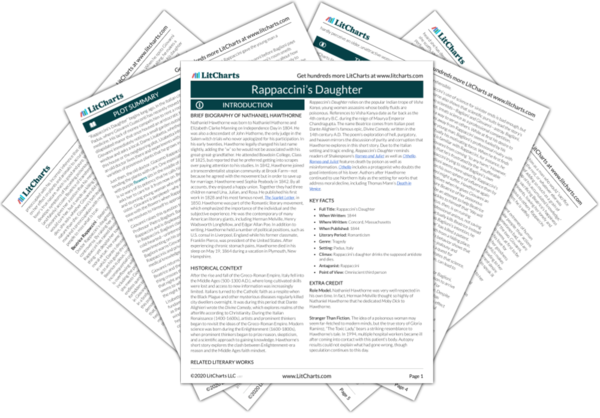Rappaccini’s garden shows the reader that it is dangerous for humans to interfere with nature. Upon his arrival in Padua, Giovanni is told that his neighbor, Dr. Rappaccini, tends a garden filled with scientifically modified plants from which Rappaccini extracts poison to make medicine. Peering into the garden, Giovanni notes that it is like a grim, modern version of the Garden of Eden from the Bible. By comparing Rappaccini’s poisonous plants with paradise, Giovanni highlights how much Rappaccini has distorted the natural order, making it impure as a result of his experiments. At the same time, the plants are vibrant, beautiful, and alluring. When Giovanni walks among the flowers, he observes, “The aspect of one and all of them dissatisfied him; their gorgeousness seemed fierce, passionate, and even unnatural.” Even though they are beautiful, Giovanni is affronted by their strangeness. Throughout the story, Rappaccini’s daughter, Beatrice, is compared with the flowers, from the sound of her voice to her scent. Both Beatrice and the flowers are beautiful yet deadly—they wound or kill anything with which they come into contact unless it is also poisonous. This dangerous power is a result of Rappaccini’s meddling with the plant. Ultimately, his interference proves disastrous. Beatrice becomes so fully poisoned that the potion she drinks to restore her health winds up killing her instead. Rappaccini’s garden shows that, while interfering with nature can be enticing initially, such interference results in unforeseen, dangerous consequences.
The Garden Quotes in Rappaccini’s Daughter
It was strangely frightful to the young man’s imagination to see this air of insecurity in a person cultivating a garden, that most simple and innocent of human toils, and which had been alike the joy and labor of the unfallen parents of the race. Was this garden, then, the Eden of the present world? And this man, with such a perception of harm in what his own hands caused to grow,—was he the Adam?

Unlock explanations and citation info for this and every other Rappaccini’s Daughter quote.
Plus so much more...
Get LitCharts A+Yes, my sister, my splendor, it shall be Beatrice’s task to nurse and serve thee; and thou shalt reward her with thy kisses and perfumed breath, which to her is as the breath of life.
For some purpose or other, this man of science is making a study of you. I know that look of his! It is the same that coldly illuminates his face as he bends over a bird, a mouse, or a butterfly, which, in pursuance of some experiment, he has killed by the perfume of a flower; a look as deep as Nature itself, but without Nature’s warmth of love. Signor Giovanni, I will stake my life upon it, you are the subject of one of Rappaccini’s experiments!
“I would fain have been loved, not feared,” murmured Beatrice, sinking down upon the ground. “But now it matters not. I am going, father, where the evil which thou hast striven to mingle with my being will pass away like a dream—like the fragrance of these poisonous flowers, which will no longer taint my breath among the flowers of Eden. Farewell, Giovanni! Thy words of hatred are like lead within my heart; but they, too, will fall away as I ascend. Oh, was there not, from the first, more poison in thy nature than in mine?”












